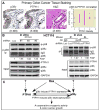PTPH1 dephosphorylates and cooperates with p38gamma MAPK to increase ras oncogenesis through PDZ-mediated interaction
- PMID: 20332238
- PMCID: PMC2848905
- DOI: 10.1158/0008-5472.CAN-09-3229
PTPH1 dephosphorylates and cooperates with p38gamma MAPK to increase ras oncogenesis through PDZ-mediated interaction
Abstract
Protein phosphatases are believed to coordinate with kinases to execute biological functions, but examples of such integrated activities, however, are still missing. In this report, we have identified protein tyrosine phosphatase H1 (PTPH1) as a specific phosphatase for p38gamma mitogen-activated protein kinase (MAPK) and shown their cooperative oncogenic activity through direct binding. p38gamma, a Ras effector known to act independent of its phosphorylation, was first shown to require its unique PDZ-binding motif to increase Ras transformation. Yeast two-hybrid screening and in vitro and in vivo analyses further identified PTPH1 as a specific p38gamma phosphatase through PDZ-mediated binding. Additional experiments showed that PTPH1 itself plays a role in Ras-dependent malignant growth in vitro and/or in mice by a mechanism depending on its p38gamma-binding activity. Moreover, Ras increases both p38gamma and PTPH1 protein expression and there is a coupling of increased p38gamma and PTPH1 protein expression in primary colon cancer tissues. These results reveal a coordinative oncogenic activity of a MAPK with its specific phosphatase and suggest that PDZ-mediated p38gamma/PTPH1 complex may be a novel target for Ras-dependent malignancies.
Conflict of interest statement
No potential conflicts of interest were disclosed.
Figures






Similar articles
-
p38γ Mitogen-activated protein kinase signals through phosphorylating its phosphatase PTPH1 in regulating ras protein oncogenesis and stress response.J Biol Chem. 2012 Aug 10;287(33):27895-905. doi: 10.1074/jbc.M111.335794. Epub 2012 Jun 22. J Biol Chem. 2012. PMID: 22730326 Free PMC article.
-
Targeting an oncogenic kinase/phosphatase signaling network for cancer therapy.Acta Pharm Sin B. 2018 Jul;8(4):511-517. doi: 10.1016/j.apsb.2018.05.007. Epub 2018 May 22. Acta Pharm Sin B. 2018. PMID: 30109176 Free PMC article. Review.
-
Reciprocal allosteric regulation of p38γ and PTPN3 involves a PDZ domain-modulated complex formation.Sci Signal. 2014 Oct 14;7(347):ra98. doi: 10.1126/scisignal.2005722. Sci Signal. 2014. PMID: 25314968
-
p38gamma mitogen-activated protein kinase integrates signaling crosstalk between Ras and estrogen receptor to increase breast cancer invasion.Cancer Res. 2006 Aug 1;66(15):7540-7. doi: 10.1158/0008-5472.CAN-05-4639. Cancer Res. 2006. PMID: 16885352 Free PMC article.
-
p38γ MAPK Inflammatory and Metabolic Signaling in Physiology and Disease.Cells. 2023 Jun 21;12(13):1674. doi: 10.3390/cells12131674. Cells. 2023. PMID: 37443708 Free PMC article. Review.
Cited by
-
p38γ and p38δ Mitogen Activated Protein Kinases (MAPKs), New Stars in the MAPK Galaxy.Front Cell Dev Biol. 2016 Apr 14;4:31. doi: 10.3389/fcell.2016.00031. eCollection 2016. Front Cell Dev Biol. 2016. PMID: 27148533 Free PMC article. Review.
-
The vitamin D receptor is involved in the regulation of human breast cancer cell growth via a ligand-independent function in cytoplasm.Oncotarget. 2017 Apr 18;8(16):26687-26701. doi: 10.18632/oncotarget.15803. Oncotarget. 2017. PMID: 28460457 Free PMC article.
-
Interactions of the protein tyrosine phosphatase PTPN3 with viral and cellular partners through its PDZ domain: insights into structural determinants and phosphatase activity.Front Mol Biosci. 2023 May 2;10:1192621. doi: 10.3389/fmolb.2023.1192621. eCollection 2023. Front Mol Biosci. 2023. PMID: 37200868 Free PMC article.
-
Regulation of TCR signalling by tyrosine phosphatases: from immune homeostasis to autoimmunity.Immunology. 2012 Sep;137(1):1-19. doi: 10.1111/j.1365-2567.2012.03591.x. Immunology. 2012. PMID: 22862552 Free PMC article.
-
MAPKs' status at early stages of renal carcinogenesis and tumors induced by ferric nitrilotriacetate.Mol Cell Biochem. 2015 Jun;404(1-2):161-70. doi: 10.1007/s11010-015-2375-5. Epub 2015 Feb 28. Mol Cell Biochem. 2015. PMID: 25724684
References
-
- Downward J. Targeting Ras signalling pathways in cancer therapy. Nature Rev Cancer. 2003;3:11–22. - PubMed
-
- Han J, Sun P. The pathways to tumor supression via route p38. Trends Biochem Sci. 2007;32:364–71. - PubMed
-
- Chen G, Hitomi M, Han J, Stacey DW. The p38 pathway provides negative feedback to Ras proliferative signaling. J Biol Chem. 2000;275:38973–80. - PubMed
-
- Qi X, Tang J, Pramanik R, et al. p38 MAPK activation selectively induces cell death in K-ras mutated human colon cancer cells through regulation of vitamin D receptor. J Biol Chem. 2004;279:22138–44. - PubMed
Publication types
MeSH terms
Substances
Grants and funding
LinkOut - more resources
Full Text Sources
Molecular Biology Databases

